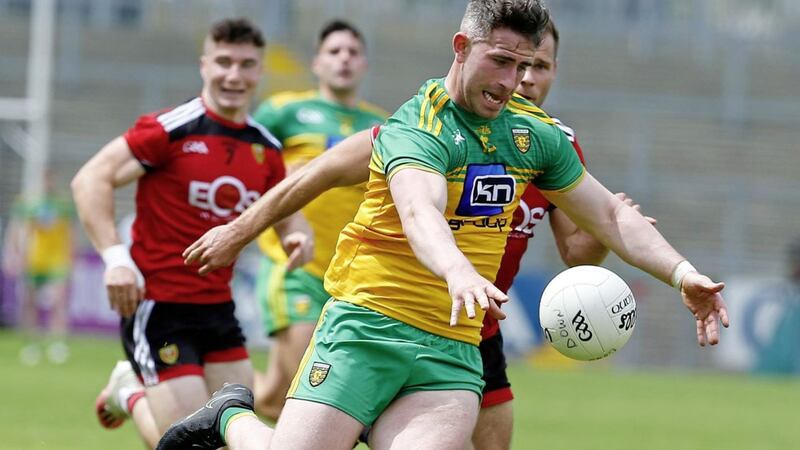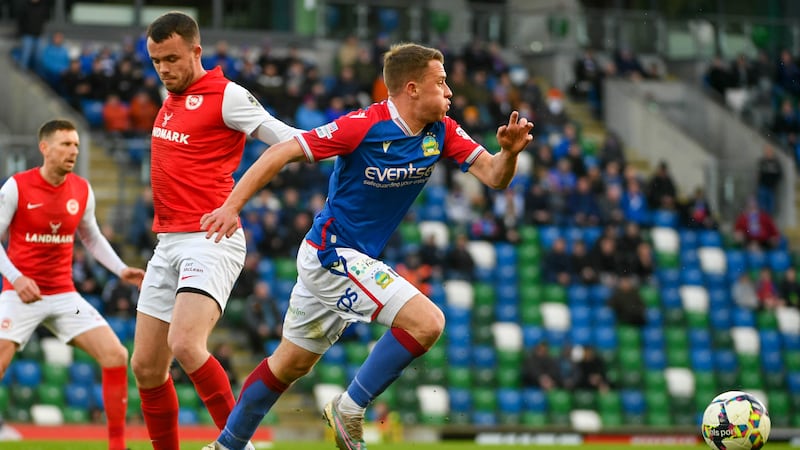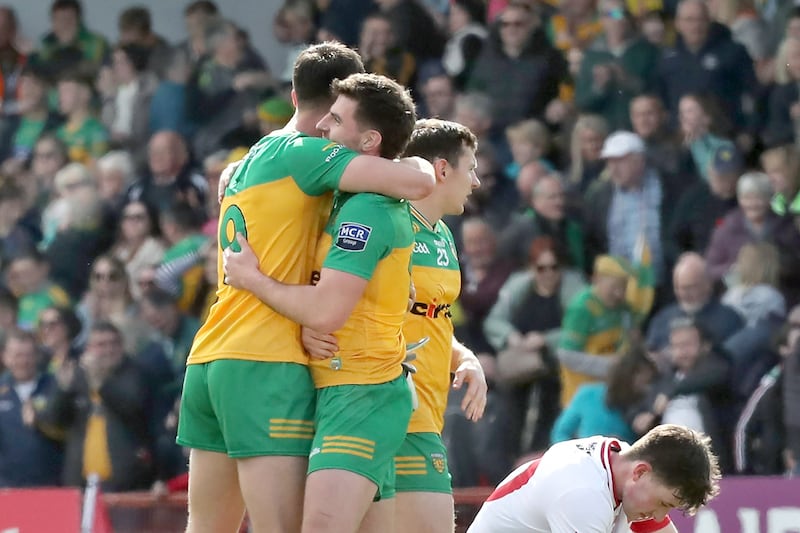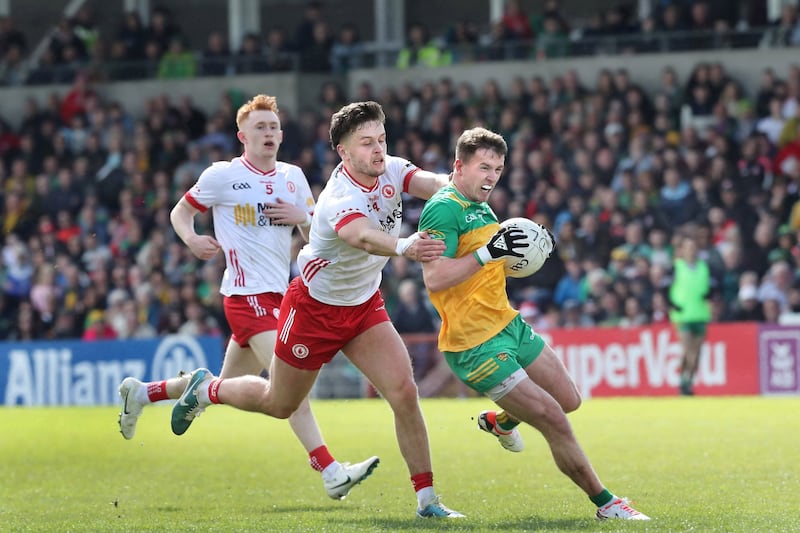GIVE or take a few, Derry will have 6,500 square metres in their own half of MacCumhaill Park to worry about when Donegal are coming at them tomorrow afternoon.
In Páirc Esler two weeks ago, Declan Bonner’s side used every millimetre of that space to their advantage.
Michael Murphy and Patrick McBrearty inside were bordering on an illusion. The TV cameras picked up the very odd ball they were kicked and it looked as though they were staying right up top.
Murphy spent his short time on the field mostly hugging the left touchline. McBrearty spent the majority of his afternoon hugging the right.
It put Down’s defence on the rack and McBrearty was in charge of the ratchet. He told the others where to run, where to be, where to leave him space.
Most of the day, he operated in 30 yards of space, one-on-one against Gerard Collins out wide, and there was very little Down or anyone else could have done about it.
Width is the new black.
Kevin Walsh divides the pitch into five or six ‘lanes’, trying to keep the opposition to the extremities, and using the mantra of Delay, Deny, Defend.
Steven Poacher talks of teams getting height and depth into their attacks too, and needing to go to basketball’s defensive approach in order to counteract its attacking one.
For Éamonn Fitzmaurice, the language is slightly less technical. The former Kerry boss believes defenders can ‘cheat in’ a bit on the opposite side but that the onus falls largely on getting pressure on the man with the ball, stopping him getting his pass away.
The three of them have all had their time at trying to devise a defensive system that would halt market leaders Dublin.
Donegal are now down the road of trying to solve an issue they created themselves.
Mark Ingle, who coached the DCU Mercy basketball team and worked with Dublin alongside Jason Sherlock during the Jim Gavin era, told an RTÉ podcast last year that the All-Ireland champions’ march down that path was a direct consequence of how small Jim McGuinness – a huge basketball fan himself – made the pitch when he was in charge of Donegal.
"He condensed the pitch, so it would only make sense to stretch the pitch,” said Ingle.
“But when you stretch the pitch, you've got to be able to have support play and move into the right areas.”
The sophistication levels that were brought to defensive strategies in the past decade are now being transferred into attacking gameplans, which in part explains how football has ripped off its own straitjacket.
Other teams have been able to see what Dublin have been doing for years. It’s one thing noticing it, and another altogether to stop it.
They go wide to create space, for men on and off the ball. They run at angles that a defender who’s caught on a standing start is beaten before his legs start to motor.
Directly or indirectly, it’s where all the goals are coming from.
So how do you defend against it?
“The only way to probably defend that is to defend narrow and defend zonally,” argues Poacher.
“Imagine 15 metres in from the sidelines, you’re leaving those areas vacant, not getting sucked out. You’d have key match-ups that would tag their men everywhere, the like of Con O’Callaghan or Clifford. If they go to the sideline, you might follow those players.”
Derry have been playing with a single spare man at the back, usually Gareth McKinless, during the League and are unlikely to deviate too far from that in MacCumhaill Park.
Their own success through the League has been built on a less advanced version of the same plan. When Fermanagh were taken from the narrow confines of Brewster Park into the wide-open hallways of Owenbeg, their hosts butchered them in the corridors of space that opened between the 14 green shirts planted inside their own 45.
“If you get your system right, one sweeper is enough,” says former Galway boss Walsh.
“It’s understanding what areas of the pitch to mark, rather than just being back in numbers.
“I’d say to you, it’s delay, deny, defend. Defend should be third. When the ball breaks down, there should be someone pushing up on the ball to delay it and at all costs, you don’t miss that tackle. Slow it up, delay it.
“Then deny it, to take the kick away, you mark the space in front of your opponent, not behind him. You deny that pass now.
“The third one would be to defend, and if you’re defending too early you’re in trouble. If you don’t delay and deny, your full-back line can end up defending one-v-one, and that’s not where you want to be.”
Nothing in football is more fashionable than the back-door cut, where a forward fakes to come forward for a ball and then darts in behind, often to the only area there’s any goalscoring space.
Conor McManus has made a career out of it. Dublin have perfected the art as a unit, and forwards all over Ireland are trying it now. Armagh scored two goals off the routine against Antrim last weekend.
Paddy McBrearty will play wide on the right (always the right, so he’s coming in on his left foot).
Whether it’s Brendan Rogers or Chrissy McKaigue, the temptation to get tight and stop him kicking points opens the avenue for the back-door cut.
So to quickly sum that up: Not tight enough, you’re in trouble. Too tight, you’re in worse bother.
How do you solve that problem?
“You’re trying to say to the inside back to be able to watch man and ball, but the last-second cut is a very hard thing to defend against,” concedes Fitzmaurice.
“If you’re the defender inside, you’d expect the man on the ball to be under severe pressure.”
Kevin Walsh counted five successful attempts at it by Dublin in their League win over Galway in Tuam, all of which they fisted over the bar when goals were on.
While watching the semi-final between Donegal and Dublin, Poacher noted that Donegal were particularly aware of it.
“You could hear the Donegal sweeper calling ‘I’ve the cut covered!’” says the Roscommon coach.
One thing they all agree on is that Derry have a serious chance in Ballybofey.
“I think Donegal’s win success the last few years is around 42, 43 per cent. It’s not consistently a massive threat,” says Walsh.
“While there’s a lot of expectation on Donegal, we’re forgetting they’ve been up and down the divisions the last few years, a lot of new players.
“They’ve been blown up to be an established team and they’ve won one or two Ulsters, their strike rate isn’t massively high. Derry will respect Donegal but I don’t think they’ll massively fear it.”
Fitzmaurice adds: “I think this game on Sunday is gonna be a great game. I think if it was on in Derry, I’d be giving them a huge shout.
“I’d still be giving them a good shout. I think they have made massive strides this year. Rory Gallagher, to be fair to him, is getting more of a balance between the traditional Derry game and being sound at the back, which would be central to his own philosophy.
“But I think the Ballybofey factor is a big factor, Donegal are so successful there,” says the former Kerry boss, edging towards a home win.
Unless Derry have the right plan in place for when Donegal try to pull them wide, they’ll be MacCumhaill Park’s latest victim.





